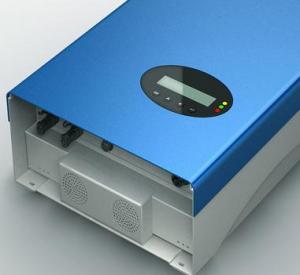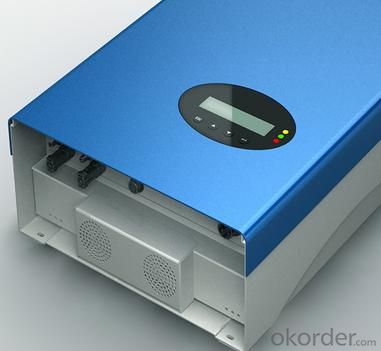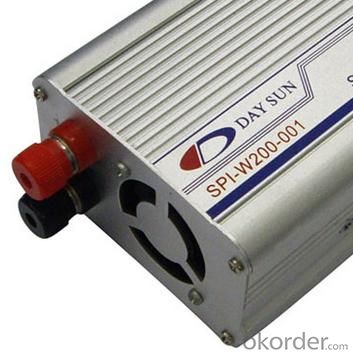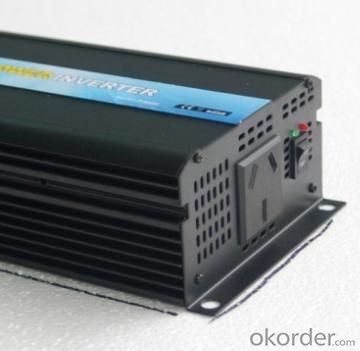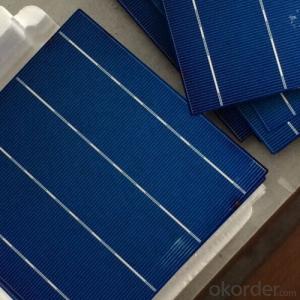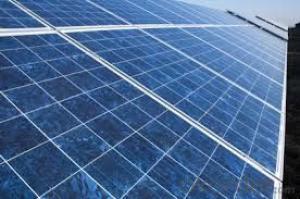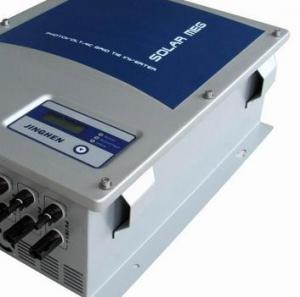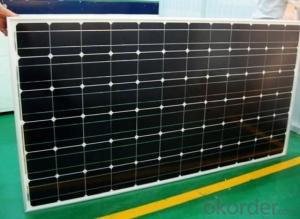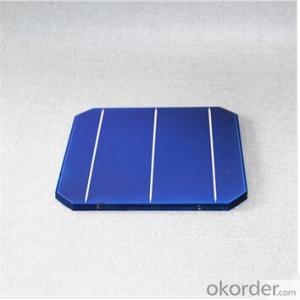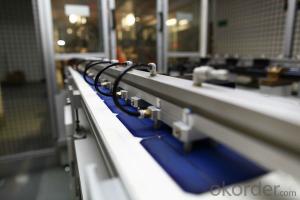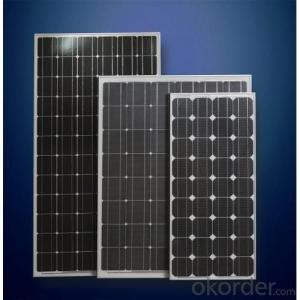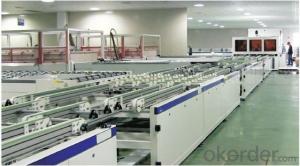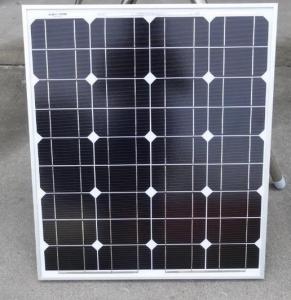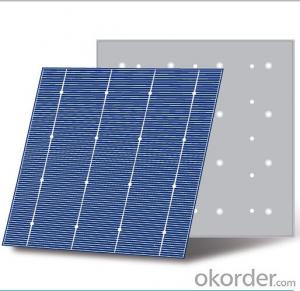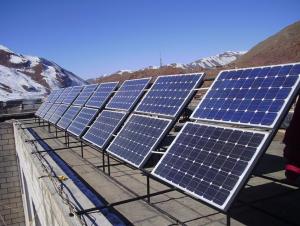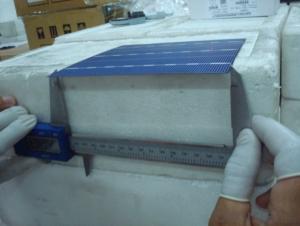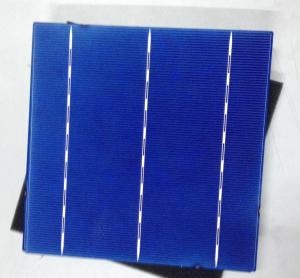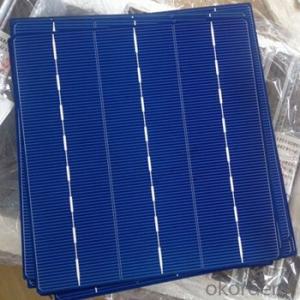High Efficiency Monocrystalline Solar Module with Organic Printed Solar Cells
- Loading Port:
- Shanghai
- Payment Terms:
- TT or LC
- Min Order Qty:
- 2250 watt
- Supply Capability:
- 30000000 watt/month
OKorder Service Pledge
OKorder Financial Service
You Might Also Like
1, Product desciption
Inverter circuits designed to produce a variable output voltage range are often used within motor speed controllers.
The DC power for the inverter section can be derived from a normal AC wall outlet or some other source. Control and feedback circuitry is used to adjust the final output of the inverter section which will ultimately determine the speed of the motor operating under its mechanical load.
Motor speed control needs are numerous and include things like: industrial motor driven equipment, electric vehicles, rail transport systems, and power tools. (See related: variable-frequency drive ) Switching states are developed for positive, negative and zero voltages as per the patterns given in the switching Table.
The generated gate pulses are given to each switch in accordance with the developed pattern and thus the output is obtained.
2, Features of the product
Inverters convert low frequency main AC power to higher frequency for use in induction heating.
To do this, AC power is first rectified to provide DC power. The inverter then changes the DC power to high frequency AC power. Due to the reduction in the number of DC Sources employed, the structure becomes more reliable and the output voltage has higher resolution due to an increase in the number of steps so that the reference sinusoidal voltage can be better achieved.
This configuration has recently become very popular in AC power supply and adjustable speed drive applications. This new inverter can avoid extra clamping diodes or voltage balancing capacitors. There are three kinds of level shifted modulation techniques, namely:
· Built-in 1 year data logger for system analysis
· Charge and discharge status display
· Acoustic load disconnect pre-warning
· Load status indication
· Choose between 5 load disconnect algorithms
· Boost/absorption/float PWM-regulation (series type)
· Integrated temperature compensation
· Covered terminals (up to 16 mm2 wire size)
· Full solid-state protection
The first thing to figure out is the length of road in need of street lights.
This can be a small entrance road only a couple hundred of feet long to miles of streets through an area. Does the area currently have any type of lighting available.
What is the reason for needing street lights in this area
Is the electrical grid already nearby or would you need to call in the power company to bring in electrical lines.
If the electric needs to be brought to the area, how much is this going to cost? Depending on how far the grid electric is from the location of the needed lighting, this can be quite expensive.
How much lighting is needed on the street? Do the lights need to be dark sky compliant.
Do the street lights need to run from dusk to dawn or for only a specified number of hours at night.
Are the street lights able to dim in the middle of the night and still provide enough lighting.
These questions need to be answered before you can decide on how many lights you will need to complete the project.
3, Product Image
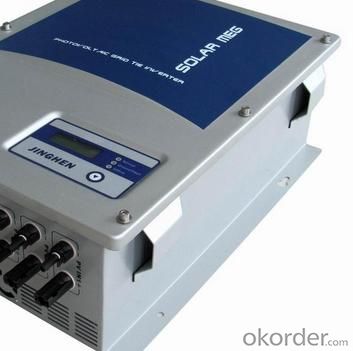
4, Detailed Specification
INPUT | |
Input voltage range | 185~265±5Vac |
OUTPUT | |
Output voltage range | 185~265±5Vac (AC mode) , 230Vac (DC mode) |
Output frequency (DC mode) | 50Hz (48~54Hz) or 60Hz(58~64Hz), same as AC(AC mode) 50Hz ±0.3Hz (DC mode) |
Wave form | Sine wave (DC Mode) |
Transfer time | 10ms. (Typical) |
BATTERY | |
Rated charging current (max.) | 45A |
Norminal DC input voltage | 12V |
Min. DC start voltage | 20V / 40V |
PHYSICAL | |
Unit dimension (mm) | 526*277*212 |
Master box dimension (mm) | 620*350*370 |
Net weight (1pc, kg) | 22.8 |
Benefits of solar cell cost
• Solar power makes up three-quarters of new U.S. electricity generation, and more than half a million U.S. homes and businesses have now gone solar.**
• You can lock in surprisingly low electricity rates by going solar with Sunrun. And we lock in those rates for 20 years. Then the next time utility rates rise, you’ll be laughing all the way to the bank.
• Your neighbors are already saving. Did you know that Americans are installing new solar panels every 3 minutes? They know that solar electricity is clean, renewable and easy on the wallet.
• Sunrun takes care of everything. We design, install, and maintain your system the entire time. We also guarantee your energy production. You get a worry-free system – while enjoying 20% savings on your electric bill.*
• It’s a nice thing to do for the environment. You can help create a planet run by beautifully clean energy from the sun.
How much money can a solar cell cost save
The real question is "Is it worth switching to solar generated power?" The answer depends greatly on your situation, economically, geographically, and politically. It's still a significant up-front investment, whether that comes out of your own pocket or you find a bank that may, possibly, with much convincing, lend it to you. The payback period - more accurately, the break-even point - or how long will it take to recuperate the cost of ownership, varies extremely. In sunny climates where electricity prices are rising, switching to solar basically locks in your electricity price and the system can pay for itself in a few years. But if you're still connected, i.e. a grid-tied system, your utility company may charge you more for using less, unless they have buy-back agreement, which most in my area do not. Also with grid-tied, if the grid goes out, you can't use your array anyway, unless you have a means of completely isolating it from utility power.
So, is it worth switching? Although the price of the components have dropped over the years, this is still a very complicated question.
In many places now, you can go solar for $0 or close to $0 down through solar leasing companies or through simple bank loans. Then you’re just paying monthly payments like you would on a house, car, or college loan. However, in this case, your payments are likely to be less than the amount of money you’re saving on your electricity bill. So, really, you’re not paying any more than you’re already paying for electricity you’re saving money!
- Q: Can solar cells be used in indoor lighting applications?
- Yes, solar cells can be used in indoor lighting applications. However, their effectiveness may vary depending on the amount of sunlight available indoors.
- Q: How to define the poly solar cells as the A Grade one?
- You can try to define it through the three factors: Efficiency, stability and durability.
- Q: What is a thin-film solar cell?
- A thin-film solar cell is a type of solar cell that is made by depositing one or more thin layers of photovoltaic material onto a substrate. These cells are typically flexible, lightweight, and have a lower manufacturing cost compared to traditional silicon-based solar cells. They can be used in a variety of applications, such as solar panels for buildings, portable electronic devices, and even integrated into clothing or other surfaces.
- Q: Can solar cells be used in data centers or server farms?
- Yes, solar cells can be used in data centers or server farms. By installing solar panels, these facilities can generate renewable energy to power their operations. However, the feasibility and effectiveness of using solar cells in data centers may depend on factors such as the location, available space, energy demands, and storage capacity. Additionally, combining solar power with other energy sources and implementing energy-efficient practices can further optimize the sustainability of data centers and server farms.
- Q: What is the impact of bird nesting on solar cell performance?
- The impact of bird nesting on solar cell performance can be significant. Bird nests can obstruct sunlight from reaching the solar panels, reducing their efficiency and overall power output. Additionally, bird droppings can accumulate on the surface of the panels, creating a layer that further hinders the absorption of sunlight. Regular maintenance and cleaning are necessary to ensure optimal performance and prevent any long-term damage caused by bird nesting.
- Q: What is the role of silicon in solar cells?
- The role of silicon in solar cells is to act as a semiconductor material that can absorb sunlight and convert it into electricity through the photovoltaic effect. Silicon is the most commonly used material in solar cell manufacturing due to its abundance, stability, and ability to efficiently convert sunlight into electricity. It forms the basis of the p-n junction, which allows for the separation and movement of electrons and holes, generating an electric current.
- Q: What is the most commonly used material for solar cells?
- It is mainly the crystalline silicon materials (including polysilicon and monocrystalline silicon), its market share in more than 90% and in the future for a long period of time will still be the main material of solar cells.
- Q: I would like to use a ppt to show how solar cells can work in a power generation factory, can anybody share some useful information with me?
- For a ppt, I think you should start with the definition of solar cells to give a basic introduction of solar cells.
- Q: What are the short-circuit currents of solar cells affected by the factors?
- Amorphous silicon cells: film thickness, membrane material conductivity, leakage, TCO conductivity, battery width, etc. are the factors
- Q: How much land is required to install solar cells?
- The amount of land required to install solar cells depends on various factors such as the capacity of the solar system, efficiency of the solar panels, and the power generation goals. On average, it is estimated that a 1 MW solar power plant requires about 4-5 acres of land. However, with advancements in solar technology, the land requirements are decreasing as solar panels become more efficient and produce more power per square foot.
Send your message to us
High Efficiency Monocrystalline Solar Module with Organic Printed Solar Cells
- Loading Port:
- Shanghai
- Payment Terms:
- TT or LC
- Min Order Qty:
- 2250 watt
- Supply Capability:
- 30000000 watt/month
OKorder Service Pledge
OKorder Financial Service
Similar products
Hot products
Hot Searches
Related keywords
